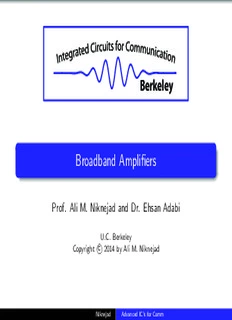
Broadband Amplifiers PDF
Preview Broadband Amplifiers
Berkeley Broadband Amplifiers Prof. Ali M. Niknejad and Dr. Ehsan Adabi U.C.Berkeley Copyright(cid:13)c 2014byAliM.Niknejad Niknejad AdvancedIC’sforComm Outline Broadband Amplifiers Shunt-Peaking Distributed Amplifiers Multi-section Matching (Bode-Fano Limits) Transformer Matching Networks Niknejad AdvancedIC’sforComm Cascade Amplifier Bandwidth Shrinkage Consider an amplifier consisting of a cascade of identical single-pole stages G 0 G(s) = 1+sτ The bandwidth of n stages can be derived as follows Gn G (s) = G(s)n = 0 n (1+sτ)n Gn Gn Gn G (jω ) = 0 = 0 = 0 | n 0 | |1+jω0τ|n |1+ω02τ2|n √2 21/n 1 = ω2τ2 0 − (cid:112) ω τ = 21/n 1 0 − Bandwidth shrinks rapidly compared to the single stage. Three stages = bandwidth drops by half ⇒ Niknejad AdvancedIC’sforComm Common Source Amplifier Bandwidth RL Cgd Rs CL Cgs Classic amplifier has several poles. The poles can be calculated as τ = C R gs gs s τ = C (R +R +g R R ) gd gd s L m s L τ = C R r L L L o || Niknejad AdvancedIC’sforComm Minimizing the effect of C in RL RL M3 CL M2 CL Rs Rs M1 The effect of C can be minimize with a cascode gd configuration. The load can be isolated with a buffer M3 (τ can be reduced) L Niknejad AdvancedIC’sforComm More Buffers RL Rs CL Similarly, the input capacitance can be isolated with a buffer (τ reduced) gs We see that we can trade speed for power consumption. Niknejad AdvancedIC’sforComm Feedback Amplifiers G0 0dB ω0 ω0G0 f For low order systems (with one dominant pole), product of gain and bandwidth is constant G 0 G = 1+sτ G G0 G G0 G = = 1+sτ = 0 = G0f+1 CL 1+Gf 1+ 1+G0sτf 1+sτ +G0f 1+sτG0f1+1 G0 G 1+T G = 1+T Gain BW = 0 = 0 1+s τ × 1+T× τ τ 1+T Niknejad AdvancedIC’sforComm Shunt-Series Amplifier RF RL Cgd By using feedback, Gain Rs CL Ri and Ro , matching ac↓quired ↓ BW Cgs ↑ R By using feedback, we reduce the gain, reduce R and R i o (desired for output matching), and increase the bandwidth Av = −RRELRRFF −+RREE Rin = RER(REF++RRLL) RE = 1+ggmmR1 Rout = RER(REF++RRSS) 1 BW A = × v Cgs + RLCgd gm 2 Niknejad AdvancedIC’sforComm Taking Advantage of a Zero R s v out v RL CL s Consider the step function of a low pass circuit. The output tracks the input with a time constant of τ: τ = C (R R ) L s L || v out t Niknejad AdvancedIC’sforComm Feedforward with a Capacitor C s R s v out v RL CL s Insight: Add a feedthrough capacitance C so that the edge S of our signal propagates to the output immediately : v C out at t = 0+ v = s v →− out C +C s RL L s RL+Rs RL Cs at t = vout = vs Cs+CL ∞ →− R +R L s t τ = R R (C +C ) s L L s || Niknejad AdvancedIC’sforComm
Description: